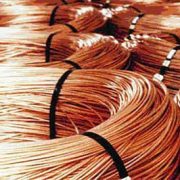
Pros of Aluminum or Copper-Clad Aluminum Wire Distance: Copper may be used over greater distances owing to its highly conductive characteristics and heat tolerance.Because copper is highly conductive, the wire strands are thinner, allowing for greater malleability without breaking. Malleability: Copper wire is more malleable and conductive than aluminum wire.Oxidation causes patina, which does not affect conductivity. Corrosion Resistant: Copper is resistant to corrosion-the color of the outer surface of copper changes when it patinas.The connections on the lugs stay tight because the copper wire does not expand and contract like aluminum. Heat Resistant: Copper wire is more heat-resistant than aluminum wire since it has better heat conductive properties.For the same level of conductivity, copper wire is around half the diameter of aluminum wire. Copper can handle a greater electrical demand so you may use a lower gauge wire. Conductivity: Copper wire is highly conductive, second only to silver.Copper wiring has several advantages, including: Why Copper Wiring is Preferred over AluminumĬopper conductors are popular among electricians and homeowners alike for branch circuits. Copper doesn’t rust and is unaffected by oxidation.

Even though copper is considered a superior conductor, it is still cheaper, lighter, and more flexible than aluminum.įor copper wiring, you’ll need a #4 AWG copper wire that is commonly used for electrical wiring since it is more heat resistant than aluminum. At the connection terminals, copper-clad aluminum does not need an antioxidant layer.Īluminum wiring appeals to many since it is less expensive, lighter, and more flexible than copper. To resist corrosion, the connection terminals of aluminum wiring require an antioxidant coating. You’ll need a #2 gauge wire for both aluminum and copper-clad aluminum wire.

Many licensed electricians use #2 copper-clad or aluminum wire size. Because aluminum wiring has a lower conductivity than copper, it requires a larger diameter wire.
#2 copper wire code#
The following table reflects wiring size, length, and voltage drop: Service or Feeder Rating Copper Wire Aluminum orĬopper-Clad Aluminum Wire Minimum Conduit Size 100 Amps #4 AWG #2 AWG 1.25 inch 110 Amps #3 AWG #1 AWG 1.25 inch 125 Amps #2 AWG #1/0 AWG 1.25 inch 150 Amps #1 AWG #2/0 AWG 1.25 inch 175 Amps #1/0 AWG #3/0 AWG 1.5 inch 200 Amps #2/0 AWG #4/0 AWG 1.5 inch 225 Amps #3/0 AWG 250 kcmil 1.5 inch 250 Amps #4/0 AWG 300 kcmil 2 inch 300 Amps 250 kcmil 350 kcmil 2.5 inch 350 Amps 350 kcmil 500 kcmil 3 inch 400 Amps 400 kcmil 600 kcmil 3 inch Source: National Electrical Code Which wire used is determined by the voltage drop and length of the wiring. *Data provided on this page is subject to change based on different manufacturers' variances ** Images are for display purposes only refer to Product Technical Details for accurate information on the product.AWG, American Wire Gauge, is the US standard for sizing electrical wiring.Ī 100 amp breaker panel requires either #4 copper wiring or #2 aluminum or copper-clad wiring. Stranding: Equipment Ground Conductor: 7.Stranding: Phase & Neutral Conductors: 7.UL Standard 83 for THHN/THWN conductors.This dielectrically strong insulation is resistant to corrosion, abrasion, chemicals, and mechanical impact. SE cable is jacketed with gray sunlight-resistant polyvinyl chloride (PVC). The cable has cross-linked polyethylene type XHHW-2 insulation. It typically has three-phase conductors with a bare neutral.


The cable is equipped with annealed soft copper conductors. Also Known As:Ģ-2-2-4 Copper SER Service Entrance Cable, 2-2-2-4 Reinforcement Tape Service Entrance Cable, 2-2-2-4 SER Cable, 2-2-2-4 SER Service Cable, 2-2-2-4 Copper Service Cable, 2-2-2-4 Round Service Entrance Cable. The voltage rating the electrical cable is 600 volts. SER is suitable for dry locations, with temperatures not exceeding 90☌. The electrical cable is most often used to connect the service drop to the meter base and from the meter base to the distribution panelboard. SER is a service entrance cable with a reinforcement tape used in all instances where service entrance cables are allowed. 2-2-2-4 SER Copper Service Entrance Wire Cable


 0 kommentar(er)
0 kommentar(er)
